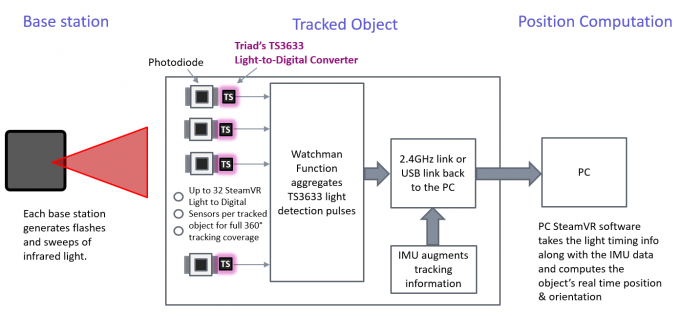With Valve’s move to open up its Lighthouse tracking technology to third parties, Triad Semiconductor is soon to be selling specialized chips which companies can use to create new VR headsets and peripherals with SteamVR Tracking.

Last month Valve finally made the first big step in opening the Lighthouse tracking technology for third-party licensing. Lighthouse is the tracking system used in the HTC Vive headset; using two sensors (‘basestations’) placed at the corners of the tracked space and an array of sensors on the headset and controllers, the system allows for ‘room-scale’ tracking that’s fast and precise enough for virtual reality. Valve said they would license the tech to anyone for free and that it would not require that third parties seek its approval before using the technology.

Valve created a ‘Licensee Dev Kit’ for SteamVR Tracking which includes a Lighthouse tracking reference device, along with sensors and boards to help companies start building new Steam VR Tracking enabled headsets and peripherals.
For those starting from scratch, Triad Semiconductor, a US firm which specializes in creating custom analog and mixed signal integrated circuits, is soon to be selling Valve-approved chips which form the foundation of the sensor array needed for SteamVR Tracking.
The appealingly-named TS3633 is a tiny ‘light-to-digital’ integrated circuit which takes input signals from a photodiode (like the small sensors seen scattered across the HTC Vive headset) and converts them into useful data for processing by the SteamVR Tracking algorithms.
Triad’s VP Marketing & Sales, Reid Wender, told me that Valve architected, approved, and certified the chip as SteamVR Tracking’s light-to-digital solution.

“This chip is Valve’s idea. The team at Valve worked with Triad to define the functionality of this chip. The Valve team consists of an incredible group of algorithmic-genius-makers. I use that weird term because the guys at Valve don’t just sit around thinking up cool product ideas and algorithms but they also immediately start hacking/making the ideas into reality on their bench-top,” he said. “Valve has an awesome vision of making SteamVR Tracking available to the world for a wide variety of precision tracking applications from room-scale virtual reality to embedded robotics control.”
Wender says that Triad is the first company to create an integrated circuit like the TS3633 for SteamVR Tracking, and that the company plans to begin selling it later this month.
In quantities of as little as 50 the part runs $0.92, and once you bump up to an order of 1,000 units the cost comes down to $0.49. A SteamVR tracked headset might have 32 sensors on it, meaning the chip would add about $15.68 to the bill of materials. Granted, you still need photodiodes and a few more components for each sensor, and that’s before considering other materials and components in the headset or peripheral.
A tiny integrated circuit like the TS3633 alone isn’t very easy to work with, at least as a starting point. So Triad is also creating the TS3633-CM1 which is a castellated module containing the TS3633, photodiode, and resistors, forming a complete SteamVR Tracking sensor for easy prototyping. The CM1 runs a steeper $6.95 each in quantities of 10, but it’s just a prototyping module rather than a finished product component. Triad says the CM1 will also become available later this month.
Wender gave a high-level overview of the structure of a Lighthouse tracked object:
- A number of Light to Digital Sensors (Photodiode + TS3633). Typical tracked objects have between 20 to 32 such sensors. Smaller numbers of sensors can be used for more ‘casual’ tracking applications.
- A digital function block to aggregate the envelope signals from each TS3633. Current systems use an FPGA that can accept up to 32 such sensor inputs.
- An IMU. The location information from the IMU gets fused with the light-to-digital angle information.
- A microprocessor to take the data from the FPGA and IMU, form packets and then send the information to a Host Processor (currently a Windows PC or Linux PC) over a USB or proprietary 2.4GHz link.
- A Host Processor running SteamVR software to serve as the “position engine.” The position engine computes the position and the orientation of tracked object.

Wender acknowledges that at this stage, creating a new device for SteamVR Tracking is still fairly complicated and accessible to many beyond engineers. With that, he says that Triad is working to create a more hacker/maker friendly approach for “simple tracked objects.” He teased that we’d hear more about this in the near future, but I suspect he may be hinting about a self-contained SteamVR tracking module which could be affixed to arbitrary objects for easy tracking.
It’s only been a month or so since Valve opened their SteamVR Tracking technology to third-parties; given that short time, we expectantly have yet to see any products with the tech hit the market, but Triad’s new chip offerings will likely accelerate things going forward.










